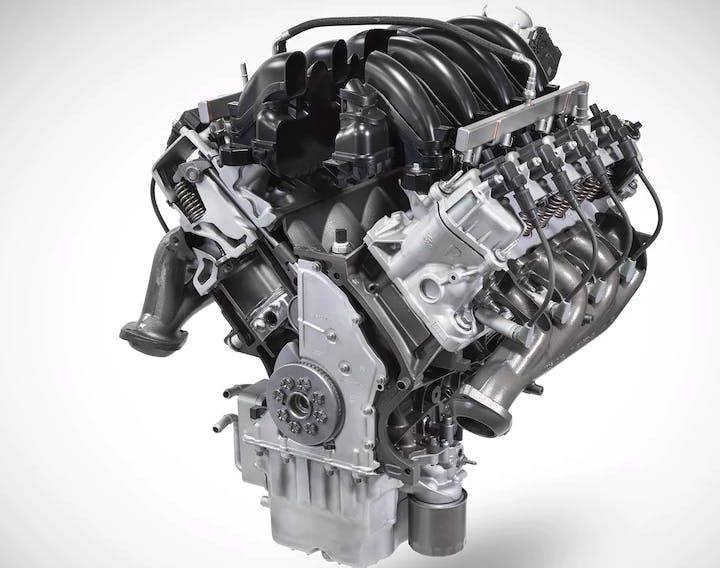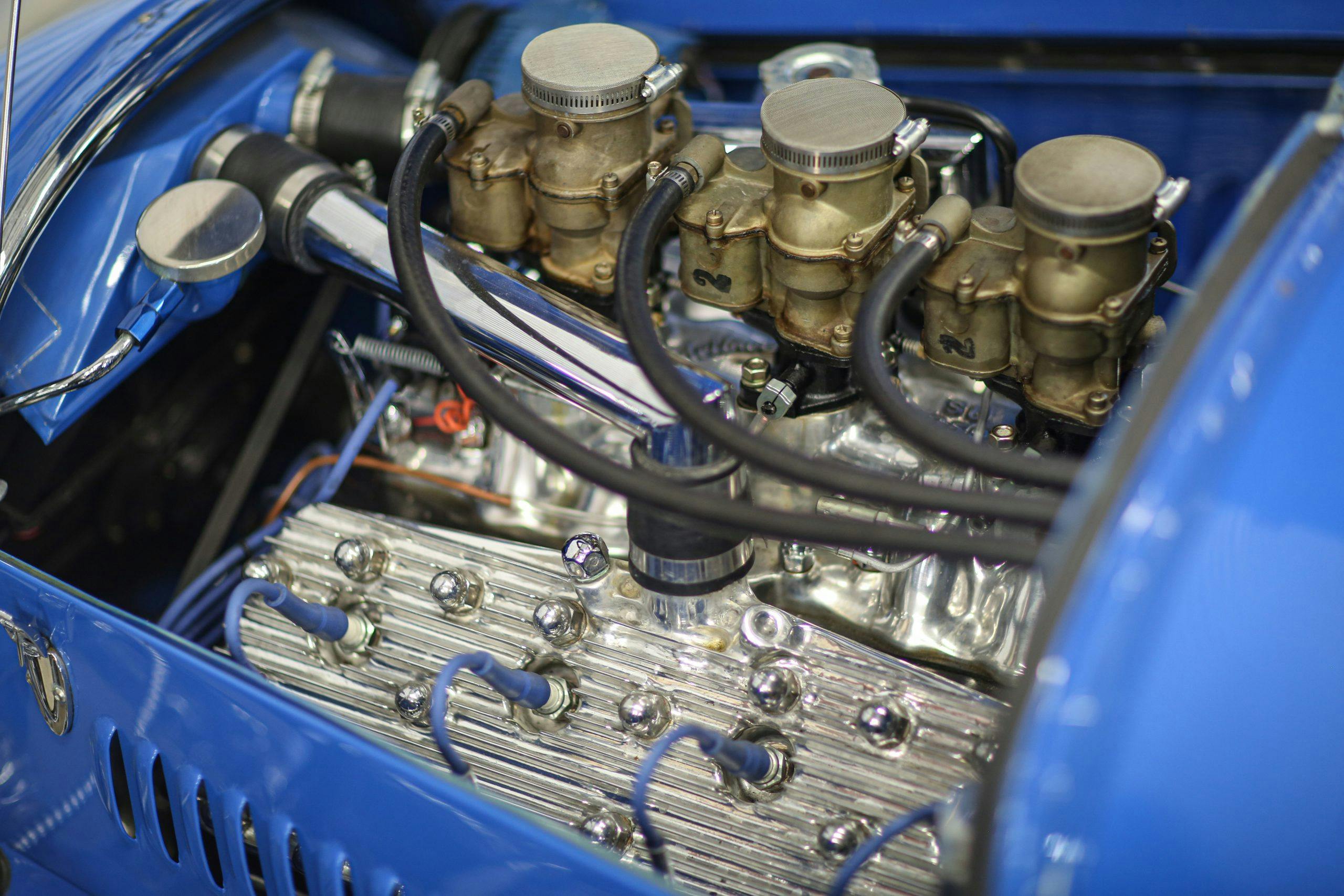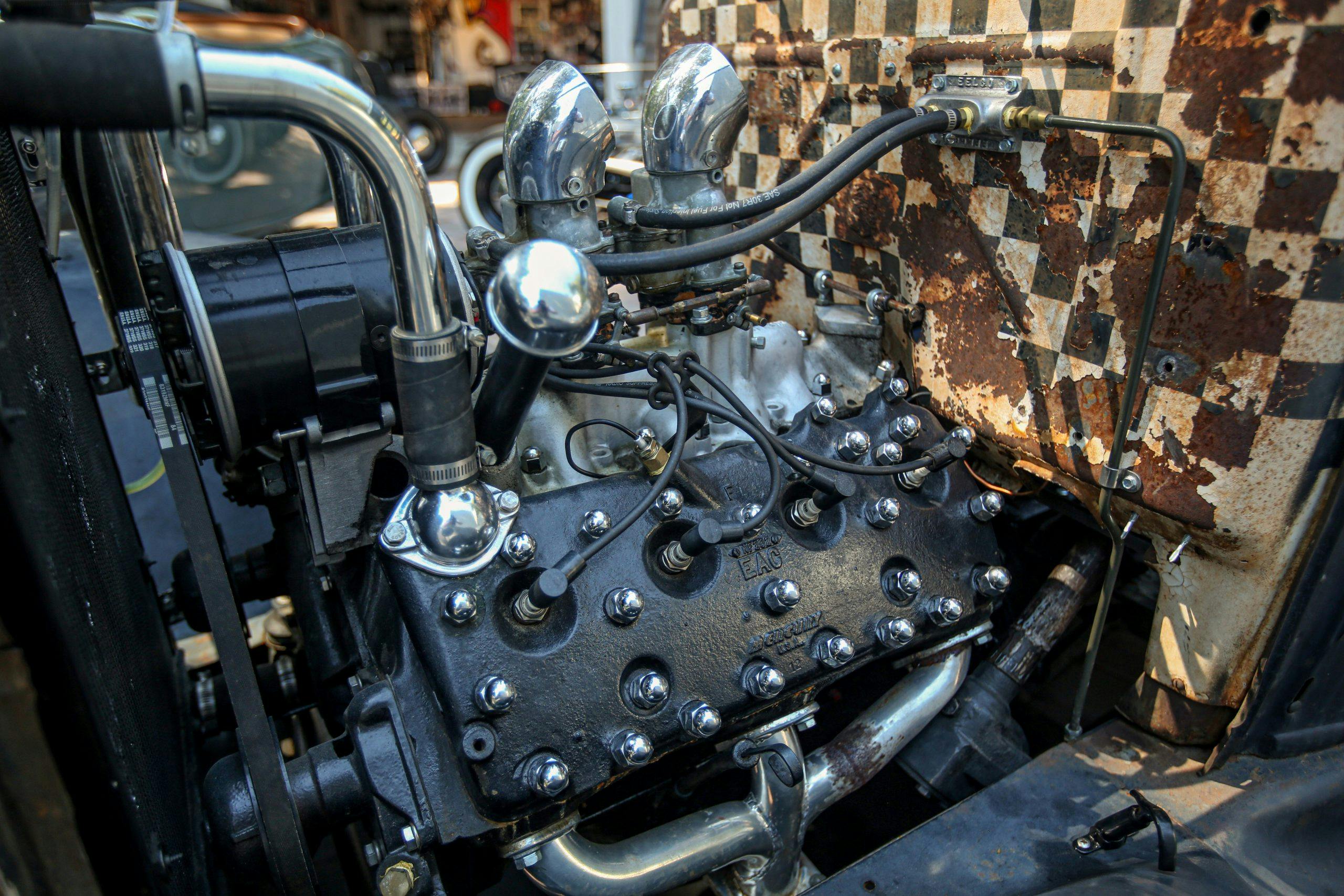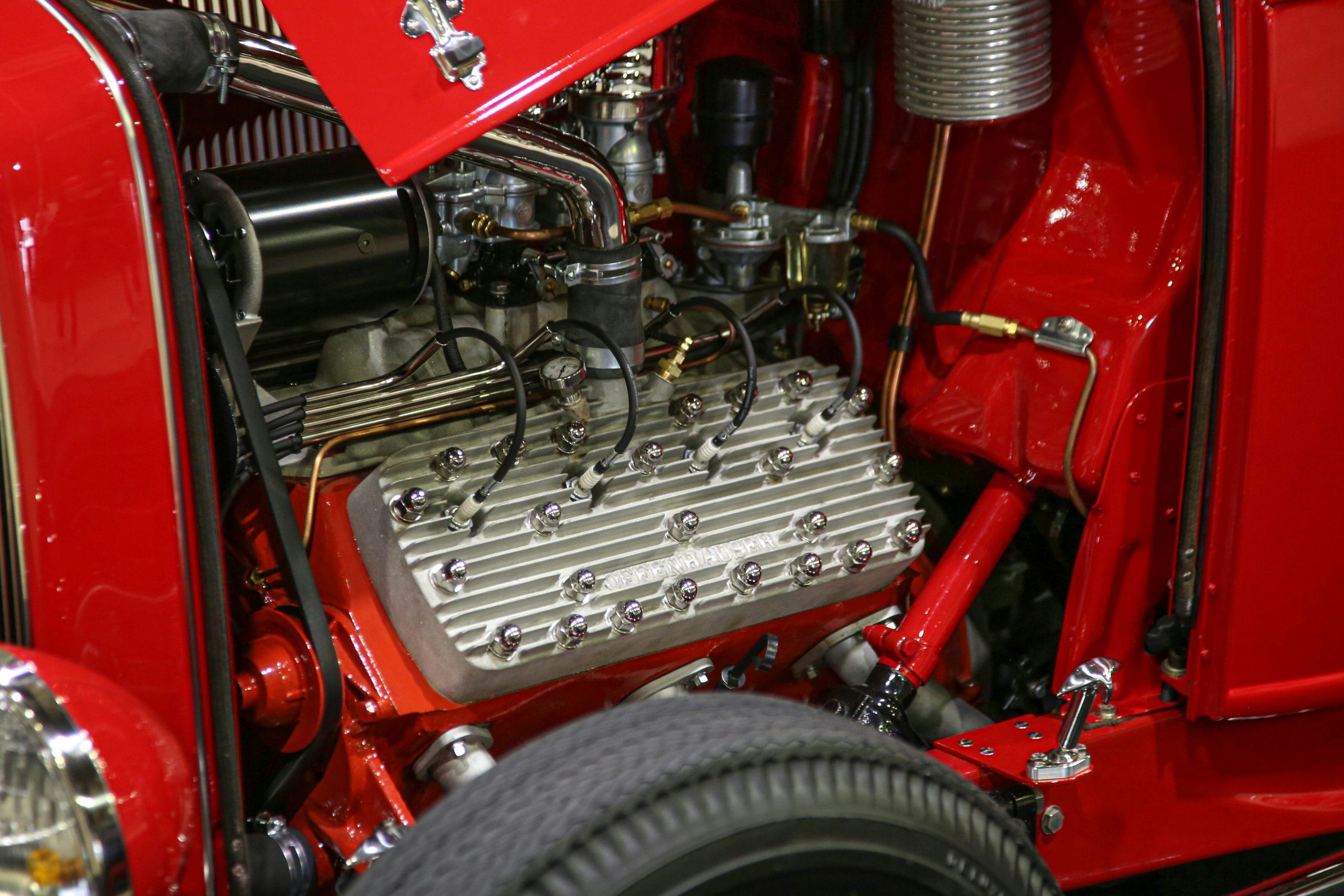Media | Articles
10 of our favorite Ford V-8s
2023 marks 120 years since Ford Motor Company was founded—on June 16, for you history buffs—and 20 years since Ford built its 100,000,000th V-8 engine. Since then, the company has made an increasing commitment to smaller, forced-induction engines. However, it certainly hasn’t given up on the V-8: The Blue Oval produced some of its best in the last 10 years.
Ford Motor Company’s 120th is a great time to look back at the company’s long history of building powerful V-8s, engines that won races, won customers, and even won wars.
Here are our favorite Ford engine families, with some standout models worth celebrating.
Flathead
1932–53 and beyond

This is where it all started. The Flathead wasn’t the world’s first V-8, and, with just 65 horsepower, it wasn’t the most powerful engine on the market in 1932, either. However, when the beautiful lines of the Ford Model 18 were met with the power of the compact Flathead V-8, the automotive world reached a milestone.
It’s hard to overstate the importance of the Flathead: In its wake, a whole industry of hot rod parts sprang up to feed racers’ need for speed. Even though the engine was phased out in the United States in 1954 in favor of the Y-block, the Flathead lived on elsewhere, notably in France and Brazil, where it was manufactured under license for passenger-car use into the ’60s. Even today, vintage hot-rod enthusiasts use the engine to power land-speed cars in classes that use the vintage castings—modern overseas castings aren’t allowed by the Southern California Timing Association.
Marketplace
Buy and sell classics with confidence
GAA V-8
1940–1960
Before the U.S. entered WWII, Ford began developing its own spin on Packard’s version of the Rolls-Royce Merlin V-12. The powerful Packard Merlin V-12s, supercharged for aircraft use, would be used in some of the most successful fighters of WWII, including the Supermarine Spitfire and North American P-51 Mustang. Unlike Rolls or Packard, Ford never built a V-12 for aircraft; it engineered the powerplant for tanks.
Ford developed a V-8 using the architecture of the Packard V-12 and the same 5.4-inch bore and 6-inch stroke. The result was a 1000-cubic-inch monster that served in a number of tanks and tanks destroyers such as the M4A3 Shermand and M10. Ford’s 500-hp V-8 was compatible with the same vehicles that used a pair of GM diesel engines. Ford did build full, V-12 versions of the engines for large tank prototypes toward the end of the war, but those twelve-cylinders never reached production.
By the way, these mid-century, DOHC engines use flat-plane crankshafts, so don’t let anyone tell you that the screaming 5.2-liter Voodoo was a first for Ford.
MEL
1958–67

Was there a better way to christen Ford’s newly minted Mercury-Edsel-Lincoln (MEL) division than with its own V-8 engine? Much like GM’s Buick, Oldsmobile, Cadillac, and Pontiac divisions, Ford decided MEL could have an engine significantly different than the FE (Ford-Edsel) engine introduced at the same time. While the MEL V-8 shared some internals (like oiling components) with the FE, the MEL was a shockingly unique design with “flat heads” that differ from those of the original Ford V-8.
Like its contemporaries, the MEL was an overhead valve design. However, while most engines of the era had cylinder heads with a combustion chamber machined into them, the MEL sported a space between the piston and the top of the cylinder’s bore, like Chevrolet’s W-series big-blocks did. From some angles that combustion chamber looks like a triangular wedge, not unlike the grille of the star-crossed Edsels that represent the “E” in MEL. Which clearly foretold a short and sad future for this engine.

For one shining moment, the MEL was the head of its class. The Super Marauder engine for 1958 sported three carburetors, an aluminum air cleaner, 430 cubic inches of displacement, and a shocking output of 400 horsepower. This was the first production engine to reach the magic horsepower number of 400, but Ford detuned it in 1959 and subsequently gave up the throne to other manufacturers. While Ford wised up and consolidated both its engine and vehicle-brand lineups, the loss of the MEL could only be eased by future big-block Ford V-8s.
FE
1958–76
Though Ford’s FE engine was built to power mid-size cars and light trucks, it evolved into several vastly different race-winning combinations. Initially launched as a 300-hp, 361-cubic-inch Edsel powerplant (FE stands for Ford-Edsel), the FE soon spread to Ford models in 332- and 352-cubic-inch displacements. However, you’re probably familiar with some of the larger displacements.
Ford’s 1-2-3 finish at the 1966 24 Hours of Le Mans came from three 427 FE–powered GT40s. The 390 that powered Lieutenant Frank Bullitt’s 1968 Mustang fastback was an FE. Shelby’s legendary 427 Cobra used an FE. Not bad bona fides for a performance V-8.
While Ford was already doing well in ’60s NASCAR competition against Chrysler’s 426 Hemi with their wedge FE cylinder heads, they still decided to get into the hemi game. It developed a single-overhead-cam version of the 427. The 427 SOHC was unfortunately banned from NASCAR competition but the few that were built saw use at the dragstrip.
From NASCAR superspeedways and NHRA drag strips to the Mulsanne Straight, the FE found success and brought home championships. It still has a niche aftermarket following and can be built into a formidable street or race engine.
Windsor
1960–2002
Ford’s compact OHV V-8 of the ’60s lived long enough to survive the malaise era and, as EFI took over for carburetors, the engine breathed life into a resurging performance market. We can’t pick one favorite from this fruitful family, which earned its nickname from its Canadian city of origin. K-Code 289s made a potent, high-winding package for early Mustang and Shelby GT350 road racers, and 1986’s sequential port fuel-injected 5.0 kicked off a performance industry of its own—who doesn’t love that fantastic, long-runer intake? In between those bookends is the yeoman 351, which served well in cars and trucks for decades.
Windsor V-8s were produced into the 21st century and used in Ford trucks. The Explorer was one of the last to use the engine, getting one of the best factory versions of the 302 using a potent set of heads that are prized by junkyard scroungers.

335 Series, aka Cleveland
1969–82
If you thought we forgot about the Boss 302, don’t worry. Known to enthusiasts as the “Clevor,” the famed Mustang Boss 302 engine was a melding of Windsor (bottom end) and Cleveland (top end). The two mills have the same bore spacing, so swapping on the big-valve Cleveland heads wasn’t a major undertaking. It was those free-breathing heads that made the engine special, so we’re including it here.
Although short-lived, the Cleveland engine family has a devoted aftermarket. The 351 and 400 engines in particular have great performance potential. The 10.297-inch deck height of the 351M and 400 Cleveland blocks makes it possible to drop in crankshafts with longer strokes, making either of these Clevelands a better candidate for a high-displacement small-block build than a 289 or 302 Windsor, each of which has a standard deck height of 9.2-inches, or even the 351 Windsor, whose deck height ranges from 9.48 to 9.503 inches (it grew taller in 1971). Ford fans in Australia love the Cleveland engine and some of the best aftermarket parts for these engines come from down under.
Indy V-8
1963–71
Lotus cars powered by Ford V-8s were some of the best-looking Indy cars of the 1960s. Displacing 256 cubic inches, the DOHC 90-degree V-8 was built to rev, and it sounded amazing. Its hot-V layout placed the intake runner between the camshafts and the exhaust ports in the valley between the heads, making for a beautiful exhaust system that was only practical in a mid-rear-engine design. In 1965, Jim Clark’s Ford-powered Lotus became the first mid-rear-engine car to win the Indianapolis 500, ending Offenhauser’s 18-year win streak.

385 Series
1968–98
Like the large-displacement big-blocks of Ford’s competitors, most of the 385 Series V-8s found their way into heavy passenger cars or 3/4- and 1-ton pickups, a workhorse role they filled into the 1990s, when the 460 V-8 was installed into scores of Super Duty trucks. However, the 385 Series—so named because of the 460 V-8’s 3.85-inch stroke—also gave birth to the 429 V-8, which used the same big, 4.36-inch bore but paired it with a 3.59-inch stroke.
The Boss 429 used the same bore and stroke combination but added monster heads with huge valves. Rather than placing all of the valves in a line, which is typically the case in wedge-shaped combustion chamber heads—shown below, on the left—the Boss 429 used hemispherical combustion chambers with valves canted away from each other. These rare V-8s are valuable collector’s pieces today, but aftermarket heads are now available to get the look and performance using a standard 385 Series bottom end.
Modular
1991–present

Plenty of Mustang enthusiasts were sad to see the 5.0 get replaced by the 4.6-liter two-valve, and we can’t blame them. When it launched, the Modular engine family didn’t have the huge aftermarket that the popular 5.0-liter Mustang GT had helped cultivate. In time, however, came better performing heads with three and eventually four valves per cylinder as well as increased displacement. The four-valve 4.6-liter was a solid performer, and plenty of drag racers have done impressive work with them, but it was the 5.0-liter Coyote that really cemented the Modular’s legendary status.
The 5.2-liter Voodoo engine found in the GT350 was the peak of naturally aspirated Modular performance at 526 hp. Swapping its flat-plane crank for a cross-plane piece and adding a massive supercharger created the 760-hp Predator engine found in the GT500. To this day, the Predator is Ford’s most powerful production engine.
Godzilla
2020–present

Ford has been all-in on OHC engines for passenger cars for decades, but it knew gasoline trucks need large displacement engines for making plenty of torque at low speeds. As the venerable 6.8-liter V-10 and 6.2-liter “Boss” SOHC V-8 were being phased out, a replacement was in order.
Enter “Godzilla,” a 7.3-liter monster that brings modern cylinder-head flow and precision manufacturing to a pushrod, two-valve V-8. In crate-engine form, it produces 430 hp and 475 lb-ft of torque. It is the largest V-8 currently produced by Ford and yet it has 4.53-inch bore spacing, meaning Godzilla is more of a small-block than a big-block.
We’re not sure how the aftermarket will respond to this engine, as it will be built in relatively low-volume due to its limited truck applications. That said, it’s still a big V-8, and all the usual hot-rodding tricks—like camshaft upgrades, cylinder head porting, and bolt-on exhaust headers—apply. We’re looking forward to seeing more of these engines under the hoods of classic Ford restomods in the future.
Those are our 10 favorite Ford engines, but of course, there are some that didn’t make the cut due to our arbitrary sense of taste. If you love either flavor of Y-Block, or perhaps a high-revving Ford NASCAR FR9 engine, make a case for it in the comments below.
***
Check out the Hagerty Media homepage so you don’t miss a single story, or better yet, bookmark it. To get our best stories delivered right to your inbox, subscribe to our newsletters.


































I think that the flathead was one of the most influential engines in hot rodding history , comparable to the small block Chevy in significance. I’m partial to Windsor engines as my second car was a 68 mustang with a 289 ( this was 1971). The 351 Windsor is under rated because of the famous 351 Cleveland but the Windsor is better in many ways. As far as fe engines, sure can’t beat the sound of one with solid lifters. Currently I have a 4.6 3valve mod. In my 08 mustang and while it’s not the most powerful iteration it’s reliable, quick enough with a few bolt one and sounds good!
I’ve owned a number of Ford V8 powered cars and trucks. All Windsor small blocks. I had a 260 in my ’64 Falcon Sprint, a 289 in my ’64 Comet Caliente, some sort of strangled version in an ’81 Mercury Zephyr (don’t remember the reduced displacement), a 302 powered ’83 Bronco XLT, a 351W powered ’69 Mustang SportsRoof, a 302 in a ’69 Mustang convertible and a 351W in a ’95 Bronco XLT. I still have the last two. Obviously I’m real comfortable with the little Windsors. My ’69 convertible is cammed up with a 351W Comp Cam, GT40P heads, Motorsport roller rockers and tri-Ys. For what it is, it can scoot. I’ve run a best 14.308 @ 99.1 mph with it and it will exceed 6 grand at WOT. That’s stronger than a number of small block Ford performance Windsor engines ran back in the day.
I have had both Ford and Chevy V8 engines in both boats and cars. I have found all in all over many years the Chevy engines required less repairs with similar performance and parts less expensive.
As to the Y block Ford, they do not provide sufficient oiling to the valve train.
In 1963 my dad bought a well used 56 Ford Customline, 4 door sedan so I had a car of my own (he wouldn’t let any of us six kids drive his cars.) It had been owned by a small town’s police chief and had the 225 hp 312 motor. A large bracket was still in place under the hood where a siren had been mounted. With it’s 3 speed column shifter in sad shape, I installed a floor shifter from Sears (of all places) and began tearing up the streets. I traded it for a brand new 66 SS 396 Chevelle making 360 hp. I won’t even start with how much of a piece of junk that car was…but OMG was it fast.
My favorite Ford motor was in a 1961 Starliner my buddy owned with a 401 hp, 390 FE engine. The car was unbelievably fast and a threat to anything that challenged it. It was rare and when the FE’s began to rule.
Thanks for the article…good work.
The MEL engines were really neat-except for the power steering pump ; )
A Chtysler 427 Hemi ? To add further insult to injury you mention the “Wedge” heads on a hemi. NO! Hemi’s stand for hemispherical heads with spark plugs on top of the combustion chamber/thru valve cover. Wedge heads on 413/426/440 Wedge motors have common combustion positioning.
We have edited that sentence to clarify that the discussion is about the FE wedge vs. the FE hemi heads.
We all have our favorites. The “FE” series is mine. Having been in the automotive trade for over 40 years, I’ve seen a lot. All the manufacturers have had good and bad engine designs. Instead of individual replies, to the Chevy 350 soft cam, Chevy had issues in the 60’s with cams, and the engines were painted orange. Also, the “410 FE” was a factory build. (not sure where that it wasn’t came from). Been a Ford man all my life, but owned other brands as well. To try to keep it short, the 390 was probably the best engine ever due to it’s use in so many vehicles. They could be neglected, beat on, overheated, over revved, run out of oil and kept on going. The 428CJ out of the box was quite the beast. I’ve owned two, and still have one of them. Actually, I have a spare engine. Also, the “FE” is still currently in use in marine and industrial applications. Ford was it’s own worst enemy back in the 60’s, keeping their good hardware from the general public. I think the bean counters got in the way. Nascar didn’t play fair with the 427 SOHC either.
Comments are better than the article!
My 39 Ford standard Tudor is my very first car. It is powered by a 1953 Ford flathead. Still runs good but only gets used a little. The big benefit- even though only gets used for a few rides each year, all you have to do is pour a little gas in the carburetor, pull the chock out three primes and it starts.
This article is entirely too vague, it’s more of a timeline not a best of/favorites.
I sure love the “Roadrunner “ V8 in my ‘13 Boss 302. It pulls from the bottom all the way to 7500 rpm and sounds awesome with the track key and side exit exhaust.
I bought a 1965 Mustang at Jack Madden Ford in Norwood, MA the day they were offered for sale in mid-April 1964. It had a 264 V8 engine, unlike the later editions sporting a 289. I don’t see the 264 mentioned in the article. Was it a variant of the Windsor?
There was a 260, but I am pretty sure there wasn’t a 264.
A couple of foot notes, the most obscure but in later days most numerous FE was the 330 cubic inch FT which powered hordes of F600 and F700 medium trucks and even some pickups, most notably 70s vintage U-Hauls. The 385 family also has a baby, the 370 truck engine which was the default mill for medium duty trucks from 1977-1991 when Ford mediums went all diesel.
The correct 385 chronology is 429 car engine, which was stroked to make the 460 car and light truck engine, which was followed by the medium duty 429 and and the 370 which was reduced bore 429. The 460 was never used in the 99 and later Super Duty series but was extensively used in 3/4 ton and 1 ton F Series and the some 92-97 F-Super Duty trucks.
I’m a FE fan. Have owned many since the 60s. My first was a 58 wagon with a 352 PI. One bummer was my 78 F250 with a 390. Ford de-tuned it for smog control and it was a dog. Currently, I have an FE in my 56 F100. Edelbrock heads, bored to 396 ci, full roller cam and lifters and a 750 Holley. MSD ignition etc. Made 500 hp on engine dyno and runs like ninja.
Did you forget about the Ford Cosworth DFV 3 liter motor that dominated Formula One with Lotus for so many years?